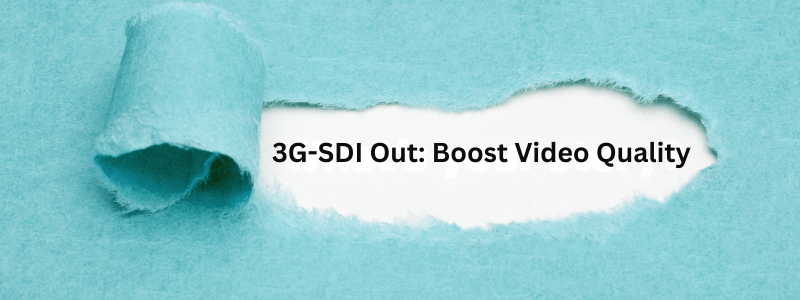
When it comes to broadcasting and video production, quality is everything. Whether you’re streaming a live event or producing content in a studio, ensuring top-notch video quality is essential. This is where 3G-SDI (Serial Digital Interface) comes into play. This article dives deep into the world of 3G-SDI Out, exploring its features, benefits, and why it’s a game-changer for anyone serious about video quality.
What is 3G-SDI?
3G-SDI stands for Third Generation Serial Digital Interface. It’s a standard used for transmitting uncompressed digital video signals. Unlike its predecessors, 3G-SDI supports higher data rates and improved performance, making it ideal for modern high-definition video applications.
Key Features of 3G-SDI
High-Definition Video Transmission
3G-SDI is capable of transmitting HD video at 1080p resolution, ensuring crystal-clear images without any loss of detail.
Long-Distance Signal Integrity
One of the standout features of 3G-SDI is its ability to maintain signal integrity over long distances. This makes it perfect for large venues and remote broadcasting.
Low Latency and Synchronization
In live broadcasts, latency can be a killer. 3G-SDI minimizes latency, ensuring that audio and video remain perfectly in sync.
Technical Specifications of 3G-SDI
3G-SDI supports data rates up to 2.97 Gbps, allowing for high-quality video transmission. It can handle various resolutions and frame rates, including 1080p at 60 frames per second. Additionally, 3G-SDI is backward compatible with older SDI standards, providing flexibility in mixed-format environments.
Benefits of 3G-SDI for Video Production
Enhanced Video Quality
With 3G-SDI, you get superior video quality thanks to its high bandwidth and uncompressed signal transmission. This means no artifacts or compression-related issues.
Reliability in Live Broadcasts
Live events demand reliable technology. 3G-SDI’s robust design ensures consistent performance, reducing the risk of signal loss or degradation.
Flexibility in Various Production Environments
Whether you’re in a studio, on location, or at a live event, 3G-SDI adapts to different setups, providing seamless integration with existing equipment.
How 3G-SDI Out Improves Video Quality
3G-SDI out, referring to the output signal from a device using 3G-SDI, ensures that the transmitted video maintains its original quality. This means minimal signal degradation and superior clarity compared to other transmission methods.
Applications of 3G-SDI in Broadcasting
Television Studios
In television production, 3G-SDI is a standard for delivering high-quality video feeds to monitors and recording devices.
Live Sports Events
Sports broadcasting benefits immensely from 3G-SDI, with its ability to handle fast-moving content without loss of quality.
Corporate Video Production
For corporate events and internal communications, 3G-SDI ensures professional-grade video quality.
Implementing 3G-SDI in Your Setup
To implement 3G-SDI, you’ll need compatible cameras, monitors, and cables. Start by connecting your camera’s 3G-SDI out to the input on your monitor or recorder. Ensure that all devices support 3G-SDI to avoid compatibility issues. While installation is straightforward, troubleshooting might be necessary to address any signal issues.
Comparison: 3G-SDI vs. HDMI
Signal Quality
3G-SDI provides uncompressed video, while HDMI might compress the signal, affecting quality.
Distance Limitations
3G-SDI can transmit signals over longer distances without degradation compared to HDMI, which is typically limited to shorter ranges.
Professional vs. Consumer Use
3G-SDI is favored in professional settings due to its reliability and performance, whereas HDMI is more common in consumer electronics.
Future of 3G-SDI Technology

As technology evolves, so does 3G-SDI. Emerging trends include higher data rates and enhanced integration with IP-based workflows. These advancements will ensure that 3G-SDI remains relevant in the ever-changing landscape of video production.
Case Studies: Success Stories with 3G-SDI
Major Broadcasters
Leading television networks rely on 3G-SDI for their live broadcasts, ensuring the highest quality for viewers.
Event Coverage
Major events, from concerts to sports, use 3G-SDI to deliver impeccable video feeds to screens around the venue.
Studio Setups
Studios benefit from the flexibility and reliability of 3G-SDI, allowing for complex setups and smooth operations.
Troubleshooting Common 3G-SDI Issues
Signal Loss
Check all connections and ensure cables are intact. Signal boosters can help if distance is an issue.
Compatibility Problems
Ensure all devices are 3G-SDI compatible. Firmware updates might be necessary for older equipment.
Maintaining System Integrity
Regularly inspect and clean connectors, and replace damaged cables promptly to maintain signal quality.
Cost Considerations for 3G-SDI Systems
While the initial investment in 3G-SDI equipment can be high, the long-term benefits, such as reduced maintenance costs and superior video quality, make it a worthwhile investment.
Expert Tips for Maximizing 3G-SDI Performance
- Use high-quality cables to prevent signal loss.
- Keep cable runs as short as possible to avoid degradation.
- Regularly update firmware for all devices to ensure compatibility and performance.
Conclusion
3G-SDI out is a powerful tool for anyone looking to boost their video quality. From television studios to live sports events, its benefits are clear. By understanding its features and implementing it effectively, you can achieve a professional-grade video that stands out.
FAQs
1. What does 3G-SDI stand for?
3G-SDI stands for Third Generation Serial Digital Interface.
2. How far can 3G-SDI signals travel?
3G-SDI signals can travel up to 100 meters without significant degradation.
3. Can 3G-SDI be used with consumer cameras?
While primarily used in professional setups, some high-end consumer cameras may support 3G-SDI.
4. What equipment do I need for a 3G-SDI setup?
You’ll need 3G-SDI compatible cameras, monitors, cables, and possibly signal boosters for long distances.
5. Is 3G-SDI future-proof?
With ongoing advancements and its current widespread use, 3G-SDI is expected to remain relevant for the foreseeable future.
For more insights on ensuring the safety and quality of your video broadcasts, check out our article on Network Security Monitoring: Protect Your Data.
